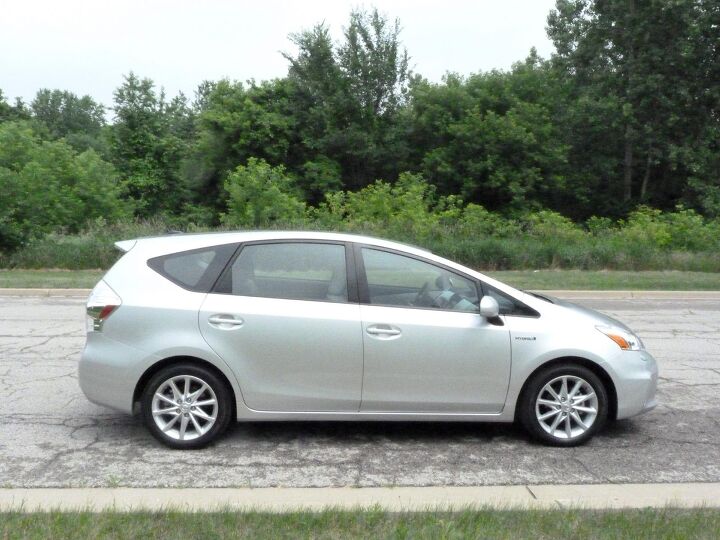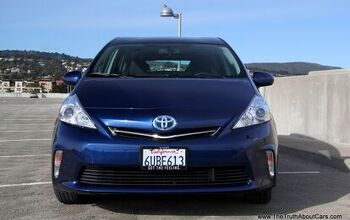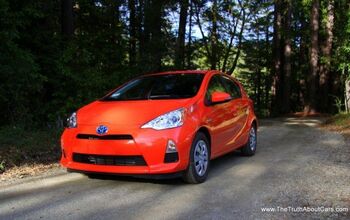Review: 2012 Toyota Prius V
Brand extensions aren’t common in the auto industry, perhaps because they rarely (if ever) succeed. Chrysler and Oldsmobile hyperextended the LeBaron and Cutlass brands, respectively, into oblivion. But Toyota has struggled as much as anyone to sell hybrids that aren’t named Prius, so it will now attempt to sell additional models under that highly successful nameplate. First up: the Prius v (with the lowercase v for “versatile”). How far and how effectively does a second model extend the reach of the brand?
Brand extensions require finesse. If the additional model is too different than the original, then it becomes unclear what the brand stands for. But if it’s overly similar, people wonder what the point of it is, if they become aware of it at all. The naming system of the new models suggests that Toyota is more likely to err in the latter direction. The original Prius and the new Prius v will later be joined by the Prius PHV (for “Plug-in Hybrid Vehicle”) and the more compact Prius c. None of these names provides much basis for an independent identity. With a Taurus X in my driveway, I’m painfully aware of the confusion that ensues when people hear a familiar model name with a single character appended. Most alphanumerics give people two or three characters to latch onto.
Worse, many people already consider their Prius a Prius V, with the V (in this case a Roman numeral pronounced “five”) denoting the top trim level. To avoid the absurdity of a Prius v V, Prius trim levels are now spelled out. So the top trim will be the Prius v Five.
The exterior styling of the Prius v similarly errs on the side of anonymity. Every exterior panel is different, and the new model is larger in every dimension (three inches more wheelbase, six inches more overall length, three inches more height, and about an inch more width). Nevertheless, few people will mistake it for anything other than a Prius with a larger, squarer rear end. Which is essentially what it is.
It took three generations, but the Prius eventually evolved into a somewhat attractive car (at least when fitted with the Five’s 17-inch alloys). With the new Prius v, we’re back to the ungainly appearance of the first two Prii (the official plural, as decided by a public vote). Engineers likely dictated the basic shape of the car, and left its designers little latitude to pretty it up. The Prius v’s interior is similarly significantly less stylish than that of the current Prius, with none of its artful curves.
This styling (or lack thereof) suggests that the Prius v is first and foremost about function. The stylish “flying buttress” center console of the regular Prius is absent. Instead, there’s a much lower, much less intrusive center console with open compartments for iPhones, purses, and such. The hood over the centrally located instruments is narrow, so the view forward is more open. To the side, the base of the side windows is more horizontal, while to the rear a much boxier rear end enables a taller, single-piece rear window. With all of these changes the Prius v feels more open and roomier, but also less stylish and less sporty. This could very well be a response to second-generation Prius owners who dislike the more encapsulated, “starship pilot” driving position of the third-generation car. In both cars interior materials are the hard plastics typical of current Toyotas, but they appear cheaper inside the Prius v. The silver plastic trim on the doors appears dated.
Like that of the regular Prius, the Prius v’s front seat is comfortable and provides more lateral support than 99.9% of economy-minded drivers will ever need. But the rear seat disappoints. Though it includes an inch more headroom and two inches more shoulder room, there’s actually a little less legroom despite the new car’s longer wheelbase and overall length. Worse, the seat cushion is lower to the floor, less comfortably shaped, and further compromised by front seats that (unlike those in the regular Prius) don’t have enough room beneath them for the rear passenger’s feet. Add up these shortcomings, and the Prius v’s rear seat is considerably less comfortable for adults than that of the regular Prius. Toyota’s product development organization dropped the ball here.
One factor: the car’s packaging had to allow for the cramped third-row seat offered elsewhere in the world. This third row isn’t offered in the United States because it requires a more compact but also far more expensive lithium-ion battery pack (in place of the standard NiMH pack). Only one buyer in twenty has been willing to fork over about $900 for the similarly limited third row in the RAV4 compact SUV. So a $5,000+ third-row seat would clearly have few takers.
With the rear seat actually less comfortable, it falls to the Prius v’s larger cargo capacity to justify its existence. The regular Prius has 21.5 cubic feet behind the second row and 39.6 with this row folded. Thanks to its longer, boxier tail, the Prius v slightly exceeds the latter figure even without folding the second row if you slide this row forward a few inches (a feature the regular Prius does not have). The average adult will still fit in this mode, just with knees grazing the front seatbacks. Sliding the rear seat all the way back leaves 34.3 cubic feet behind it. With the seat folded, 67.3. These figures, a substantial improvement over the regular Prius, compare well to the compact SUVs Toyota names as the car’s primary target. A folding front passenger seat would make the Prius v even more versatile, but one is not offered.
The Prius v’s 134-horsepower (98 from the 1.8-liter gas engine) hybrid powertrain is unchanged from the regular Prius. A shorter final driver ratio (3.70 vs. 3.27) compensates for the larger car’s heftier curb weight (3,274 vs. 3,042 pounds), so acceleration is about the same. As in the regular Prius, the powertrain mode makes a big difference. Select “eco” and acceleration could hardly be more leisurely. Though accelerating very slowly feels surprisingly good in the Prius v because the powertrain in this mode is so smooth and so quiet, the drivers in your rearview mirror clearly find the experience much less relaxing. In the default mode, the powertrain feels substantially more responsive, and in “power” it feels almost quick. Work the powertrain hard, though, and it makes quite a bit more noise and has the unnatural, non-linear feel common with a CVT.
EPA ratings are much lower with the Prius v, 44/40 vs. 51/48. The differences compared to the regular Prius aren’t large—a little less slippery (the drag coefficient is 0.29 instead of 0.25), a little more frontal area, a little more weight, a shorter final drive ratio—but they apparently add up, at least within the EPA’s lab. Perhaps the Prius v wasn’t as thoroughly tweaked to gain a few tenths here and a few tenths there?
Suspension tweaks for the Prius v focused on ride quality, and the car does ride more smoothly and quietly than the regular Prius. Handling, not a Prius strongpoint to begin with, is a little less sharp but still more controlled than with the first- and second-generation Prii. Understeer and lean in hard turns are moderate. The tires rather than the suspension are very much the limiting factor. When they slide they do so progressively and without much audible fuss. Given its role as an efficient appliance, the Prius v handles well enough. Those seeking a more involving driving experience should check out the similarly functional, similarly efficient Volkswagen Jetta SportWagen TDI.
Since the Prius v shares its powertrain and many other parts beneath the skin with the regular Prius, reliability should be excellent. Prius owners participating in TrueDelta’s Car Reliability Survey have consistently reported very few repairs. Critics of the car have often stressed the danger of expensive battery pack failures, but these are hardly ever needed before 150,000 miles. A new battery pack runs about $2,500, but people have paid only a few hundred for packs out of wrecked cars with low miles.
Toyota hasn’t yet announced pricing for the Prius v, but suggests it will cost only be a little more than the regular Prius. The difference had better be $1,000 at most, for the Prius v doesn’t offer much more than the regular car. There’s significantly more cargo space, better outward visibility, and a less constricted driving position, but fuel economy takes a hit and the rear seat is surprisingly less comfortable. The Prius v doesn’t risk damaging the brand—it’s too similar to the regular Prius for this—but since the car is essentially a Prius wagon it’s hard to see why Toyota went through the trouble of developing an all-new exterior and interior. With a largely clean sheet and more inches to work with, why aren’t the exterior and interior more attractive, and why isn’t the rear seat much roomier? Unlike with the regular Prius, no one was swinging for the fences. The Prius v certainly isn’t a bad car, but it is nevertheless an opportunity squandered.
Toyota made this vehicle available for review at a regional launch event. A pre-production review can be found here.
Michael Karesh operates TrueDelta, an online source of automotive pricing and reliability data.
,
Michael Karesh lives in West Bloomfield, Michigan, with his wife and three children. In 2003 he received a Ph.D. from the University of Chicago. While in Chicago he worked at the National Opinion Research Center, a leader in the field of survey research. For his doctoral thesis, he spent a year-and-a-half inside an automaker studying how and how well it understood consumers when developing new products. While pursuing the degree he taught consumer behavior and product development at Oakland University. Since 1999, he has contributed auto reviews to Epinions, where he is currently one of two people in charge of the autos section. Since earning the degree he has continued to care for his children (school, gymnastics, tae-kwan-do...) and write reviews for Epinions and, more recently, The Truth About Cars while developing TrueDelta, a vehicle reliability and price comparison site.
More by Michael Karesh
Latest Car Reviews
Read moreLatest Product Reviews
Read moreRecent Comments
- Jeff Overall I prefer the 59 GM cars to the 58s because of less chrome but I have a new appreciation of the 58 Cadillac Eldorados after reading this series. I use to not like the 58 Eldorados but I now don't mind them. Overall I prefer the 55-57s GMs over most of the 58-60s GMs. For the most part I like the 61 GMs. Chryslers I like the 57 and 58s. Fords I liked the 55 thru 57s but the 58s and 59s not as much with the exception of Mercury which I for the most part like all those. As the 60s progressed the tail fins started to go away and the amount of chrome was reduced. More understated.
- Theflyersfan Nissan could have the best auto lineup of any carmaker (they don't), but until they improve one major issue, the best cars out there won't matter. That is the dealership experience. Year after year in multiple customer service surveys from groups like JD Power and CR, Nissan frequency scrapes the bottom. Personally, I really like the never seen new Z, but after having several truly awful Nissan dealer experiences, my shadow will never darken a Nissan showroom. I'm painting with broad strokes here, but maybe it is so ingrained in their culture to try to take advantage of people who might not be savvy enough in the buying experience that they by default treat everyone like idiots and saps. All of this has to be frustrating to Nissan HQ as they are improving their lineup but their dealers drag them down.
- SPPPP I am actually a pretty big Alfa fan ... and that is why I hate this car.
- SCE to AUX They're spending billions on this venture, so I hope so.Investing during a lull in the EV market seems like a smart move - "buy low, sell high" and all that.Key for Honda will be achieving high efficiency in its EVs, something not everybody can do.
- ChristianWimmer It might be overpriced for most, but probably not for the affluent city-dwellers who these are targeted at - we have tons of them in Munich where I live so I “get it”. I just think these look so terribly cheap and weird from a design POV.















































Comments
Join the conversation
After 2 tough winters in Southeast PA, I was wondering how a hybrid handles in the snow? I'm getting close to replacing my '99 civic coupe, which the only thing I never liked about it was how it handles in the snow.
Test drove one last week. While not looking that much larger than the Prius side by side, it seems to have much, much more space inside compared to my previous test drives in a regular Prius. I'm still unsure of what we'll end up buying, but the v made a very strong case for itself. It was planted, easy to drive, and comfortable. Fitting a rear facing child's seat won't be a problem and the sliding and reclining 2nd row makes things a little more configurable. The display audio/Entune was slick and very easy to sync w/ my iphone 4. For someone looking to start a family, it seems like it will be a great vehicle.